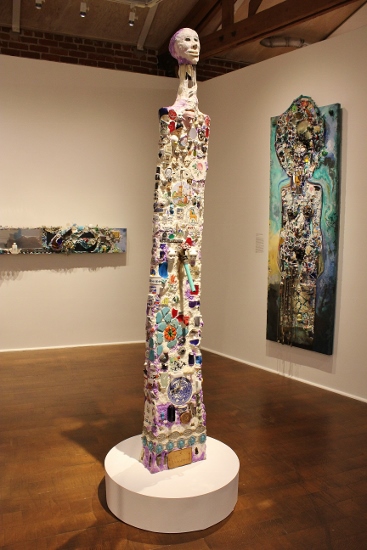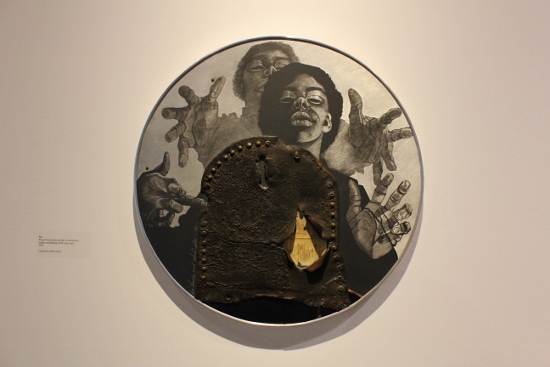
Timothy Washington is one of the artists in WATTS, The Loft at Liz’s, 453 S. La Brea Avenue, Los Angeles, CA 90036.
From January 16 until February 15, 2016.
Final Notice, 2002-2013.
About:
(review of his solo in Craft and Folk Art Museum LA, LATIMES, Sharon Mizota, March 2014)
Now in his late 60s, Los Angeles artist Timothy Washington is enjoying his first solo museum exhibition. Associated with the 1960s assemblage movement in South L.A., Washington is a contemporary of David Hammons, Betye Saar, John Outterbridge and Noah Purifoy, but has never quite achieved the same level of recognition.
Several Faces, one Race, 2011.
In his joyous, eclectic exhibition at the Craft and Folk Art Museum, it’s not hard to see why. Washington was and is a far more eccentric and mystical artist, traits that haven’t always found favor in the mainstream gallery and museum world.
From his powerful early drawings on metal printing plates, to whimsical sculptures coated with a near overwhelming assortment of found objects, he has created curious, sometimes searing works that adhere to no logic but their own.
The drawings on metal, dating mostly from the late 1960s and early ’70s, are the reverse of the etching process. Washington scraped away a layer of auto primer on the surface, effectively removing the ink rather than creating a groove for it to sit in.
1A, 1972.
They depict stolid, ghostly figures emerging from mysterious black grounds. Some are relatively naturalistic, such as in the tondo “1A,” which Washington created in defiance and frustration upon receiving his draft card during the Vietnam War. Other figures have staring, round circles for eyes, giving them a slightly haunted look.
Sculptures from this time are even more bizarrely alien. “Love Thy Neighbor” from 1968, looks a bit like a Star Wars droid, an armless metal figure with a vaguely canine head and a torso studded with hundreds of nails.
The legs of “The Energy Source: First Warning” from 1970 tower over most viewers’ heads; they are topped with an upended, skeletal-looking saddle and a pair of metal wheels. The piece is part of a Bible-inspired series, but also intimates a connection with extraterrestrial life. Sun Ra, that pioneer of Afrofuturism, would be proud.
Old and New, 2012.
Like his contemporaries whose practices matured in the ruins of the 1965 Watts riots, Washington is an inveterate recycler; integrating everyday castoffs into his singular, spiritual visions. In the 1980s he developed a technique in which he coated metal armatures with a gummy concoction of cotton and glue. Embedded into this lumpy surface are myriad bits of broken plates, timer dials, doll parts, shards of glass, toys and all manner of detritus.
God Is, 1974.
These assemblages mostly take the form of otherworldly figures. “Love” from 2013 includes a vitrine built into its chest that holds objects given to him by friends. “Has an Introduction” from 2011 was inspired by the sharp spines of a kapok tree but has the whimsical feel of a children’s television character. “Futuristic Animal (Harley Davidson)” from 2004 is a goat-like creature that nods towards Rauschenberg’s “Monogram” — a taxidermy goat encircled with a tire — but then so exceeds its eclecticism as to thoroughly short-circuit the comparison.
Washington is on his own wavelength, one that thrills and revels in excess and the random collisions of detritus on the street — and in one’s brain — to spawn a highly personal symbolic order.
Los Angeles Times





